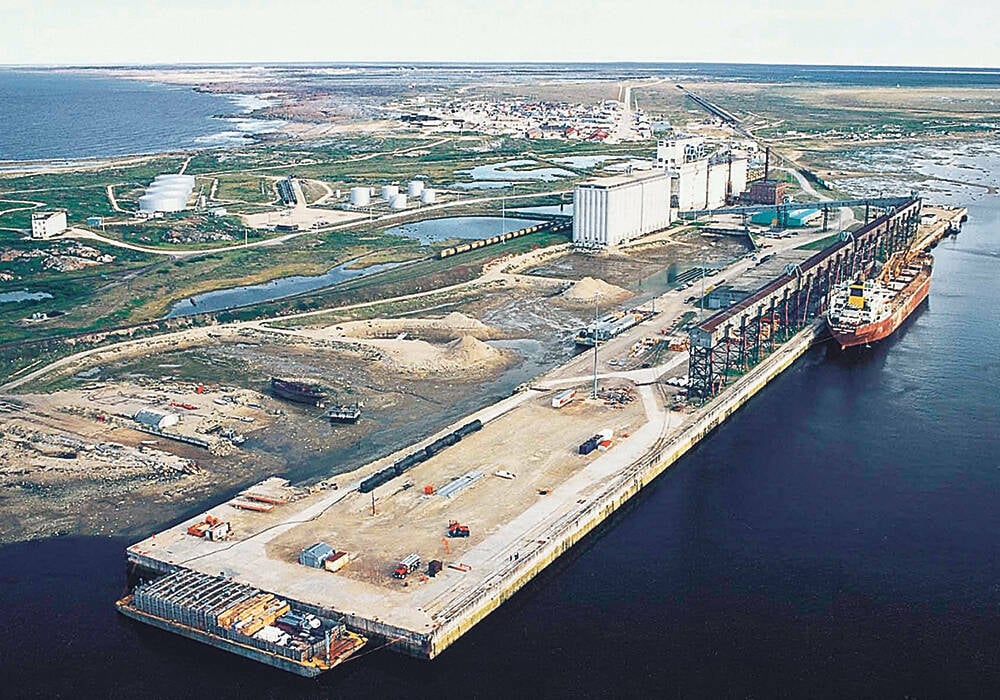Western Canadian agriculture, and Manitoba industry in particular, has learned to have a little caution with their optimism when it comes to the Port of Churchill.
It’s Canada’s only rail-serviced deep sea port in the Arctic. It would be closer for agricultural goods than ports on the East or West Coast. It was, in fact, a player in grain trade before the death of the Canadian Wheat Board. But its agricultural significance had also slid in the 2010s and, for several years after 2018, service disruptions, ownership transfers, and big price tags for needed upgrades were major challenges.
That landscape, though, may now have shifted in Churchill’s favour. Tariffs are pushing governments to find new trade solutions, the North has seen more open waters longer in the year and provincial and federal governments seem to be brushing the dust off their Churchill file in earnest.
Read Also

Feds drill for foot-and-mouth outbreak
Foot-and-mouth drill mocks up Canadian disease defence, looks for gaps, should an infection be found in the U.S.
WHY IT MATTERS: The Port of Churchill may have a role to play in Canada’s economic development and sovereignty, but bringing the facility and its rail access up to snuff will require a lot of backing.
The federal government and the Province of Manitoba recently confirmed a five-year, $262.5-million investment to bolster capacity at the Port of Churchill, the adjoining Hudson Bay Railway as well as overall operational diversity.
It’s the latest in a string of promises. Stakeholders in Saskatchewan have courted the port, such as last year’s partnership with Invest Tisdale, while joint funding between the Manitoba and federal governments since 2018 had grown to $293 million as of March of last year.
First steps
The port is in the initial stages of an ambitious upgrade, dubbed “Port of Churchill Plus.”
The goalposts of that plan include year-round shipping, Class 1 railway services and an all-weather road to the Churchill town site.
In a Nov. 17 release, Manitoba Premier Wab Kinew announced $51 million for port owners Arctic Gateway Group to make capital improvements for their rail line and to build a new critical minerals storage facility. That brings the province’s share of recent funding to $87.5 million. The five-year commitment includes the federal government’s $175 million announced earlier this year.
On track
There’s a lot of work left before Churchill can serve as a 24-hour port of call, but Arctic Gateway CEO Chris Avery said the existing town, port and railway offer a solid foundation to build on.
“The civic infrastructure (is) designed for about 5,000 people. The population today is less than 1,000, so we have all the infrastructure there from sewage to plumbing to housing and electricity and so on,” he said at Keystone Agriculture Producers’ National Advisory Council Nov. 12.
“The Port of Churchill and the Hudson’s Bay Railway is very much open for business now. We have all the infrastructure. We have the rail access to the port. We have the grain elevator ready to go in Churchill and we have the port undergoing additional investments for it to be ready to export commodities around the world.”

Calling the expansion a “once-in-a-generation” opportunity to diversify the port’s shipping capacity, Avery said a high percentage of its business priorities will continue to focus on agriculture.
“The core backbone of Churchill has been — and we expect will be in the future — agricultural products and particularly agricultural products produced right here in Manitoba.”
Major projects nod
Port of Churchill Plus also made the Major Projects Office transformative strategies list in September. Prime Minister Mark Carney’s economic strategy in the face of trade uncertainty has included efforts to fast-track certain big infrastructure projects identified for nation building potential.
Avery divides the campaign to grow the Port of Churchill into two eras: pre- and post-Trump.
The core goals before United States President Donald Trump was elected remain, he said, but they’ve expanded in number, magnitude and necessity as Canada seeks trade diversity.
“In the first half, we talked about the Port of Churchill being a gateway to European markets, continuing to rebuild the traffic,” he recalled.
“And then the second half was the post-Trump era, where we found ourselves in a position where we are actually looked to as a potential major port in Canada in support of our national goals, which are to diversify trade away from the U.S., to help drive Canada forward as a global energy superpower, to assert our sovereignty in the north and to advance economic and Indigenous economic reconciliation.”
“The core backbone of Churchill has been — and we expect will be in the future — agricultural products and particularly agricultural products produced right here in Manitoba.”
Chris Avery
ARCTIC GATEWAY GROUP
That Indigenous input is significant. Arctic Gateway is owned by One North, a partnership of 29 First Nations. Not only does Arctic Gateway own and operate the port and the railway, but also the Churchill Marine Tank Farm — a large fuel storage facility.
“Our ownership group really prioritizes Indigenous and northern jobs for training and for development.” said Avery. “They insist that we upkeep the infrastructure because their ownership depends on that infrastructure.”
Railway in ‘best shape it’s ever been’
Avery offered a status update of recent and future port developments.
For example, the Hudson Bay Railway has a track quality index that’s “consistently high across all parts of the railway,” Avery said.
“We’ve reduced travel time on the railway by about 10 per cent or three hours, and that’s just because the rail line is in good condition and we’re not asking trains to slow down as much,” he noted.
There have also been much needed repairs to the facility, including the wharf face and the wharf deck.
The capabilities of the port have also expanded. “We’ve exported critical minerals from the Port of Churchill for two years straight now. We’ve tripled the amount of bulk storage capability. What we’re doing is diversifying the commodities that will trade through the Port of Churchill.”
Open water, open trade
There’s also research from the University of Manitoba investigating how many months the sea lanes leading from the port can stay open if icebreakers are used to clear them, part of the revamps goal of year-round trade.
“The sea lanes right now are open for about four months of the year … University of Manitoba tells us that (the sea lanes) can, without icebreakers, be open for about six months of the year already, given climate change,” Avery noted.

Those findings are currently going though peer review.
Anecdotally, however, Avery said he’s personally seen the shift in sea ice. “I was up in Churchill on Monday, all the sea lanes are wide open,” he said.
Last year, “the sea lanes on Dec. 22 were wide open from Churchill all the way up to the Hudson Strait and into the Atlantic Ocean.
“So that’s a sample size of one, but you get the idea of what’s happening with regards to climate change,” he said.
The Royal Military College in Kingston, Ont., and Laval University in Quebec City, Que., are also working on the project.
Railway needs to support heavier cars
There are still upgrades needed on the rail line’s car-carrying capacity.
“We need this upgrade to allow rail cars that carry a gross weight of 286,000 pounds per car,” Avery said. “Our line allows cars that are weighted 268,000 pounds per car.”
“That’s only a difference of about seven per cent, but that seven per cent, as you can imagine with the agricultural companies, mining companies and other companies, it makes a big difference in terms of optimizing their distribution logistics.”
Private sector expected to pick up the ball
Michael Clark, director with the Manitoba Beekeepers’ Association, posed a question of overall cost to Avery. How big is the bill to upgrade all structures noted in Port of Churchill Plus?
Avery didn’t give a precise number, but said the cost of railway upgrades, roads and year-round sea lanes would require hundreds of millions of dollars in investment, much of which will come from government coffers. However, that initial investment could unlock billions in private sector investment.
“A road for the province to build on its own is quite cost-prohibitive. But if the private sector is building pipelines and other infrastructure, then building a road alongside that would be far more economical,” he said.
















